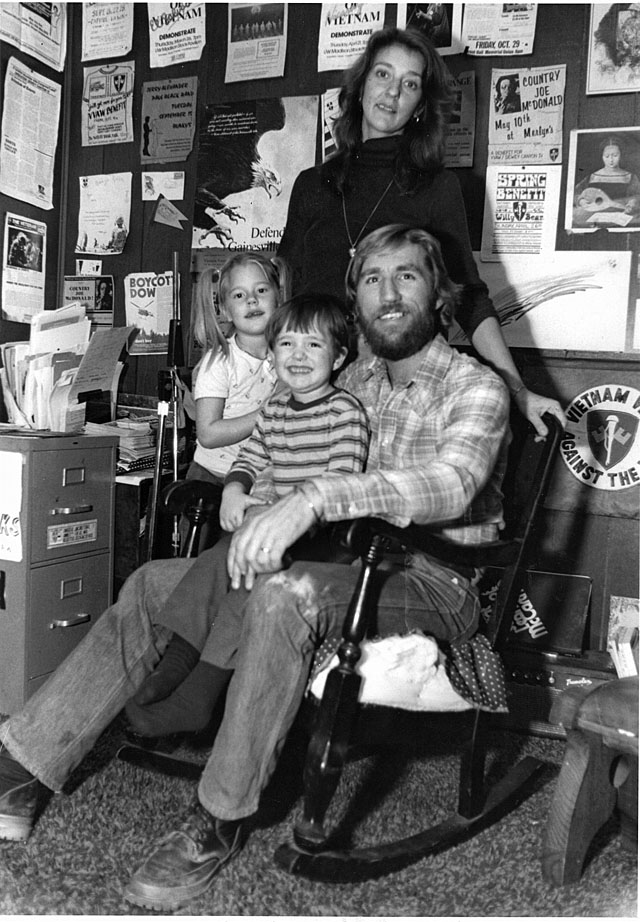 |
||||||||||||
|
THE LEGACY OF AGENT ORANGE, May/June 2012
THREE GENERATIONS OF BY JIM BELSHAW
It began in Vietnam, where Jim was exposed to the defoliant. In 1976 his daughter, Ree Anne, was born with health issues so severe, she was not expected to live. Two years later, when their son, Zachary, was born, doctors said he would be little more than a vegetable. But Zak Wachtendonk would earn more than one college degree, and he became a successful computer expert who worked in information technology for the state of Wisconsin. He died at the age of thirty in 2009. Both children were diagnosed with eye and muscle disorders, epilepsy, autism, brain deformities, bone deformities, and other serious health problems. The children suffered so many seizures that the Wachtendonks stopped calling for ambulances. “We just stayed with them until the seizures ended,” Jim said.
No one in the family has received VA aid related to Agent Orange exposure. “This forty-year struggle has been absolutely horrific for our family,” Sukie said. Although Jim is 100 percent disabled, he has never been listed in the VA Agent Orange Registry. The VA, instead, recognized other service-connected disabilities not related to Agent Orange, including chloracne rash, chromosome damage, and peripheral neuropathy. The Wachtendonks have lost a home, gone through bankruptcy, and moved repeatedly to put distance between themselves and municipalities that sprayed various chemicals they said brought dangerous reactions in their children. “My kids were being exposed everywhere they went,” Sukie said. “Once, Zachary didn’t stop seizing for almost four days; Ree Anne for two and a half days. Zachary was eight months old, our daughter was two years old. Both went into grand mal seizures.” Sukie and Jim Wachtendonk now live in rural Wisconsin, as far as they can get from areas where chemicals are routinely sprayed. They find peace in the land. “There are a lot of guys like me who live out in the sticks,” Jim said. “Some guys are in the middle of hundreds of acres. I’ve got a nice piece of land that Sukie found for us.” Long active in veterans’ affairs and the effort to bring light to the Agent Orange issue, Sukie has been forced recently to focus on her own battle with breast cancer. For forty years, she and her husband have been at the forefront of the fight, finding strength in a simple and eloquent concept to see them through it: “Love for each other,” Sukie said, “and a love for the land and the need to make it a better place—not only for our children, but for other people’s children.”
Her husband served as an Army K-9 handler at Da Nang. He remembered the spraying and remembered its effect on the vegetation. “If this is what it does to chlorophyll,” he had thought, “what’s it doing to us?” “I needed answers,” Sukie said. “I needed to find out what was going on with my children. That was the motivation: to keep them alive and to find out what was happening to us.” She sought answers at the medical libraries of the University of Wisconsin. She also attended and testified at hearings on Agent Orange. People had very different reactions. Some embraced her; others condemned her as nothing less than treasonous. “When I was done testifying, I found several veterans and wives waiting for me,” she said. “They were with the VVAW [Vietnam Veterans Against the War]. I started working with them to do research for a class-action suit. In 1978 Jim and I were the first in Wisconsin to sign on.” Others at the hearing were not so welcoming. “I became an enemy of the state, which is just crazy,” Sukie said. “I’m just a mom. Because we were doing research on Agent Orange, organizing vets, and educating the public, I was called a communist and a traitor. I was told I was an over-emotional, chemical-phobic woman.” Ree Anne required long hours of care. She was unable to roll over or lift her head. Sukie worked with her four hours a day. Doctors warned Sukie and Jim that Ree Anne could suffer brain damage and even death after necessary brain surgery. Nonetheless, she is thirty-five now, the mother of two children. Two years after Ree Anne’s birth, Sukie found herself working just as hard with Zachary. “I had to teach him how to raise his head, walk, and crawl,” she said. “They told me he would be a vegetable, but he wasn’t a vegetable. He was a successful human being. He was sweet, and he was my hero.” She is frustrated that Jim is not on the VA Agent Orange registry. “We were one of the first people to register, and he’s not there,” she said. “They don’t see him for Agent Orange stuff. They won’t admit it. My husband is just a ‘crazy PTSD vet’ married to a nutty wife, and they have sick kids, and it doesn’t have anything to do with the VA. The rank-and-file people at the VA have been terrific. It’s the upper-uppers who don’t want to be responsible for anything. And it’s all about money. Nobody wants to touch us with a ten-foot pole.” For most of his life, Jim Wachtendonk had found strength and solace in music. He had played the guitar since he was a boy of six or seven. All through his struggle with the effects of Agent Orange he continued writing and playing his music, performing at hotels and concerts, including the 1984 HBO veterans concert. But when illness made the guitar difficult for Jim, Sukie made a suggestion that started him down a different artistic road. Seeing a small set of watercolors one day, she suggested that he try painting. He has been painting ever since, eventually branching out to three-dimensional art. “It never would have happened if Sukie hadn’t put that thought in my head. It was so important. She’s in many of my paintings. She’s the keeper of the light.” He wanted to create public art with a purpose. One piece struck a chord with the community. He spray-painted a 30-gallon drum white, then added a 10-inch orange ring around it. He displayed it in the Richland County Bank for a week. A sign attracted the attention of bank customers: “Do You Know Someone Touched by Agent Orange? If you know someone touched by Agent Orange, please write down their name on my art barrel as we remember. Perhaps so shall others.” “There’s a couple of pens there, and folks have been going in and writing down the names of loved ones,” Jim said. “My goal as an artist is to have folks fill that thing full of names, and then I’ll paint another. That’s action, right?” Other Faces of Agent Orange, including a separate profile of Ree Anne Wachtendonk, are located on the Agent Orange page of the VVA website, www.vva.org Jim Wachtendonk’s songs, poetry, and prose can be viewed at www.booneytunes.net
|
||||||||||||
 |
||||||||||||
 |
||||||||||||
| |
||||||||||||
|
||||||||||||
8719 Colesville Road, Suite 100, Silver Spring. MD 20910 | www.vva.org | contact us |
||||||||||||







 Jim and Sukie Wachtendonk’s forty-year struggle with Agent Orange stretches across three generations. It touches not only the Vietnam veteran and his wife, but their children and grandchildren. Each generation has faced birth defects and debilitating disease.
Jim and Sukie Wachtendonk’s forty-year struggle with Agent Orange stretches across three generations. It touches not only the Vietnam veteran and his wife, but their children and grandchildren. Each generation has faced birth defects and debilitating disease. 
